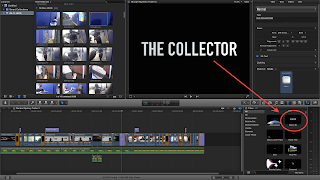Transitions
Transitions
Video transitions are a post-production technique used in film or video editing to connect one shot to another. Often when a filmmaker wants to join two shots together, they use a basic cut where the first image is instantly replaced by the next. However when a filmmaker wants to convey a particular mood, jump between story lines, switch to another point of view or move backwards and forward in time this is when more artistic transitions are used.
Fade in/Fade out
A fade is when the scene gradually turns to a single color usually black or white or when a scene gradually appears on screen. Fade ins occur at the beginning of a film or scene, while fade outs are usually at the end. A fade to black (the most common transition type) is a dramatic transition that often symbolizes the passage of time or signifies completion. Fading to black is used to move from a dramatic or emotional scene into another scene, or to the credits at the end of a film. Fading to white, on the other hand, can be used to create a sense of ambiguity or a sense of hope.
In the scene above it shows a cat going towards building and then it fades to black to show a burglar in the building. I believe this is in relation to the noun cat burglar. This creates a sense of mystery and intrigues the audience, encouraging them to keep watching.
Graphic Match
A graphic match occurs where a scene quickly cuts between showing one thing, and showing something seemingly unrelated in a different location. This can serve to forge a connection between the two things and implies that they are somehow related. In some cases, this can be metaphorical, and when done in an artistic manner it can have a lasting impact on the audience.
An example of this is from this scene in Psycho by Alfred Hitchcock. There is a cut between the dead woman's eye and the water draining down the plughole. This suggests that as she lies there, her life is draining away, just like the water. This is a very powerful comparison and makes the scene memorable.
Wipe
A wipe is another kind of transition which is not often used nowadays, as technology allows for smoother and more visually pleasing transitions. However, the wipe was once a popular way of moving the narrative from one location to another. As the name suggests, the screen is literally "wiped" by the introduction of the next shot, which serves to show that time has passed or the location has changed.
The wipe transition was famously used in Star Wars; an example of this can be seen in the clip above. At the time, this editing method was seen as revolutionary.
Graphic Match
A graphic match occurs where a scene quickly cuts between showing one thing, and showing something seemingly unrelated in a different location. This can serve to forge a connection between the two things and implies that they are somehow related. In some cases, this can be metaphorical, and when done in an artistic manner it can have a lasting impact on the audience.
An example of this is from this scene in Psycho by Alfred Hitchcock. There is a cut between the dead woman's eye and the water draining down the plughole. This suggests that as she lies there, her life is draining away, just like the water. This is a very powerful comparison and makes the scene memorable.
Wipe
A wipe is another kind of transition which is not often used nowadays, as technology allows for smoother and more visually pleasing transitions. However, the wipe was once a popular way of moving the narrative from one location to another. As the name suggests, the screen is literally "wiped" by the introduction of the next shot, which serves to show that time has passed or the location has changed.
The wipe transition was famously used in Star Wars; an example of this can be seen in the clip above. At the time, this editing method was seen as revolutionary.


Comments
Post a Comment